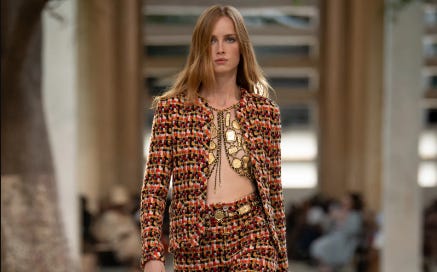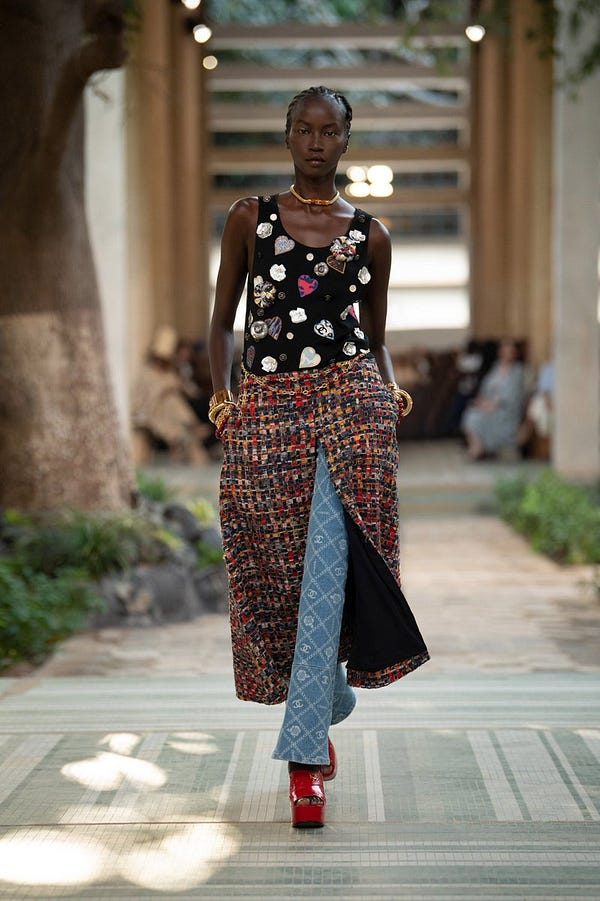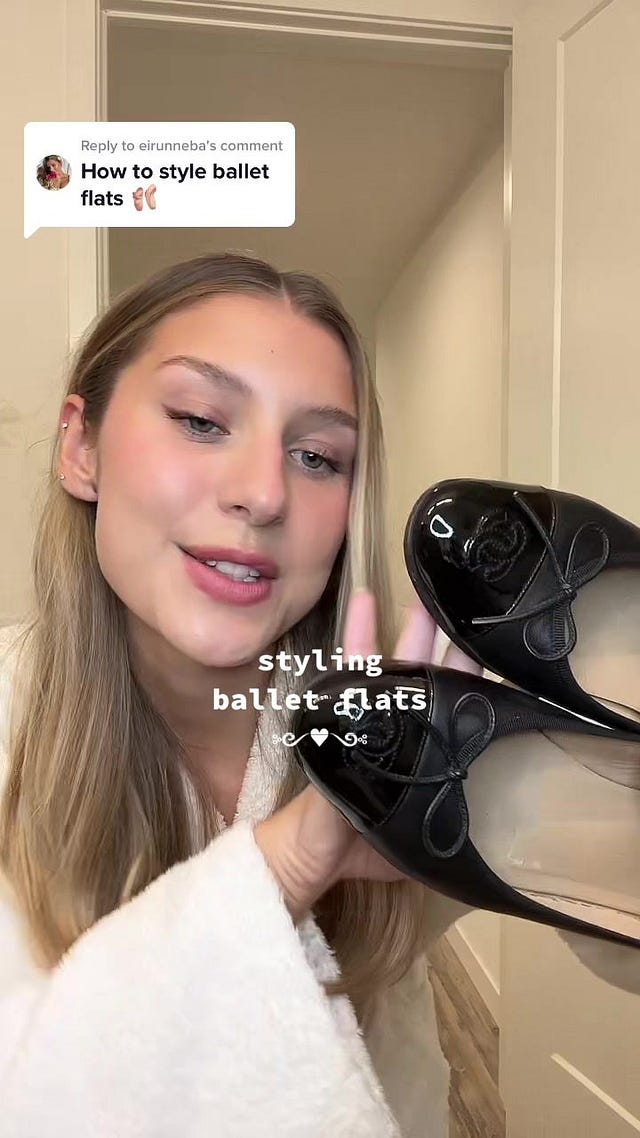This Editor’s Letter is, and will remain, free to view by all, however, future pieces will be available to paid subscribers only.
Editor’s Letter, 12/12/2022 by Molly Elizabeth Agnew
There are perhaps two fashion houses that have stood the test of time and reigned as the most classic, classy and quintessentially French designers. Both reached their heights of success and influence during the mid-20th century and had a renaissance in the 90s and early 2000s with John Galliano and Karl Lagerfeld at their respective helms. The last decade, however, is when these most beloved companies have begun to stray from one another. Under the creative leadership of Maria Grazia Chiuri, Dior’s sales have steadily risen from 3,800 million euros in 2013/14 to 6,608 in 2021 and while Chanel’s sales have risen positively too, the outpouring of love for the brand has, in turn, declined. Or has it?
They do say that social media channels can prove to be somewhat of an echo chamber, hence the importance of seeking out views that may differ from your own to keep perspective. If you find yourself often frequenting high fashion Twitter (also written down as hf twt because, well, it’s Twitter) you may come to the conclusion that Chanel has completely lost any spark with gen z. At the time of writing, Chanel showed their pre-fall 2023 collection yesterday and the reception has been…well, as frosty as the weather in the United Kingdom currently. Held in Dakar, the capital of Senegal, this was the first time the French house had shown a collection in Africa meaning all eyes were going to be on this performance, perhaps more so than usual. After all, this is just a pre-fall collection. The collection was typical Chanel, full of tweed and two-piece suits, which on their own are nothing new or revolutionary, but generally respected by all fashion watchers. The main problem with this show? Styling.
This seems to be Chanel creative director Virginie Viard’s biggest mistake, or at least the easiest to rectify. Styling can absolutely make or break how your collection is received on the runway, and if the runway isn’t a success then the collection may struggle in stores and online.
However, the argument always made in defence of Chanel and, quite frankly, their continually disappointing runway showings is that, clearly, something is working if their sales are so positive. So, what is actually working for them and bringing them this monetary success?
For quite some time now, Chanel has been viewed as the French fashion house for the more mature woman. A woman who is heading towards, or already in, her retirement looking for refinement and a modest, classic style that still screams money. In general, an older clientele is more likely than their younger counterparts to stay loyal to a fashion brand, sticking with what they know they enjoy and what makes them feel good. In my view, this is Chanel’s most vital asset. Viard knows this and therefore makes sure that a reasonable chunk of items in any collection is designed with these customers in mind. Thus, they play it safe, not seeking to ever stray too far from their comfort zone knowing this will always bring them a sturdy profit. One could argue that there isn’t much wrong with this, after all, why shouldn’t a designer keep doing what they know will bring in the money? Not every single fashion house is destined to be an experimental hub aiming to attract the avant-garde. However, at least online, many Gen Z’s seem to be bored of this and perhaps that’s simply because many of these collections and individual designs aren’t aimed at them. And that is okay!
Except that, in actuality, Chanel does seem to somehow be growing in popularity with the younger generations. In Fashionphile’s 2021 Ultra-Luxury Resale Report, Chanel was one of the most searched brands amongst Gen Z sitting with other brands such as Gucci, Prada and Saint Laurent. What aspects of Chanel are we young folk interested in? Well, you’d have to be living under a rock to not have noticed the meteoric comeback of the ballet flat and its most classic and timeless rendition, the Chanel flat.
One quick search of ‘Chanel flat’ in TikTok will reveal a world of Chanel lovers collecting, styling and boasting about their new or old leather shoes. The rise in their popularity is down to ballet core making a comeback. This trend heavily features ballet-inspired flat shoes and let’s just say, we’re all falling for the micro trend. The majority of Chanel’s sales each year are their accessories, not their garments.
Chanel has a complicated relationship with its celebrity ambassadors. There is a reason we all pray that Margot Robbie gets released from her contract (more on this in a moment.) Every now and then though they really do get it spot on, such as dressing Olivia Rodrigo in one of their classic tweed skirt suits. The skirt was hemmed above the knee and they accessorised with white ankle-length socks and chunky white platform heels. Essentially, they modernised the look all while keeping the ensemble appropriate for the White House where it was worn. As many remarked at the time, it had an air of Cher Horowitz.
Alas, this is one of the few examples of Chanel jumping on the 90s comeback train and adapting their items for a younger audience. Instead, they sign contracts with celebrities who end up looking dull and drab on the red carpet. In the last month, Margot Robbie had a brief stint wearing Bottega Veneta and my oh my did she shine! You could feel her confidence radiating. It was only a matter of time, unfortunately, before she was back in Chanel and that glow dissipated. Red carpets require, most of the time, an element of elegance, glamour and well, red carpet about them. To put it simply, a tweed Chanel suit does not an Oscar’s outfit make. Of course, Chanel does have its couture line but as many would agree, the feeling of ‘couture’ is fleeting.
There is a reason that I mentioned Dior at the top of this piece and that is due to the fact that Dior has managed to do what Chanel has not. Dior has made a concerted effort to attract Gen Z. While Chanel puts emphasis on signing deals with celebrities who do little to inspire, Dior employs content creators and social media personalities to reach a younger demographic. They have reimagined many of their iconic accessories, such as the Lady Dior and the saddle bag and marketed them, using content creators and young celebrities, to great effect. Their beauty division has thrived as the Dior Lip Glow Oils and Addict Lip Glows have stayed at the top of trending makeup lists. How have they achieved this? They created a product they knew would merge with the world of ‘clean’ and ‘minimal’ beauty. They covered it in luxurious packaging. And, once again, utilised social platforms such as TikTok to their benefit knowing that with good money behind them they could make a viral product. They have moved with the times.
Like Chanel, and the majority of well-known luxury brands, Dior mainly generates sales from accessories, not garments. However, this hasn’t stopped Maria Grazia Chiuri from putting decent effort into her ready-to-wear and couture collections. Their Spring 2023 ready-to-wear and Spring 2021 couture collections are perhaps two of the most notable for the Italian creative director in recent years. While sometimes Dior’s collection do receive fair criticism for playing it too safe, there is still a clear ability to create magic.
Dior has played the game and done so with outstanding results. Chanel is still many steps behind. While Chanel may keep the love and loyalty of its older and most dedicated clients for now, there will eventually come a time when this won’t be enough to keep them afloat. When ballet flats cease to be the main fashion trend once again, what, if any, items will Gen Z cling to?
Karl Lagerfeld once said of joining the fashion house,
“When I took on Chanel, it was a sleeping beauty. Not even a beautiful one. She snored. So I was to revive a dead woman.”
Perhaps it is time for someone new to do just the same.










